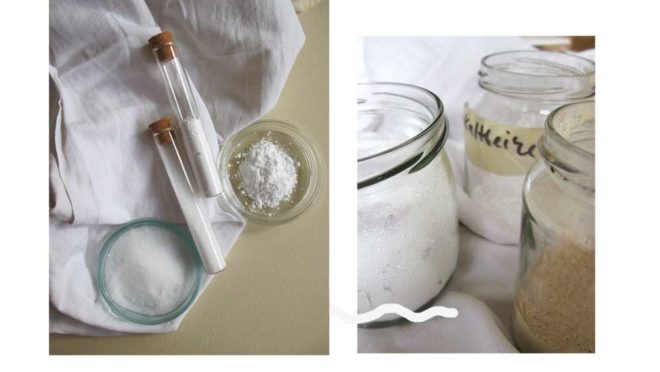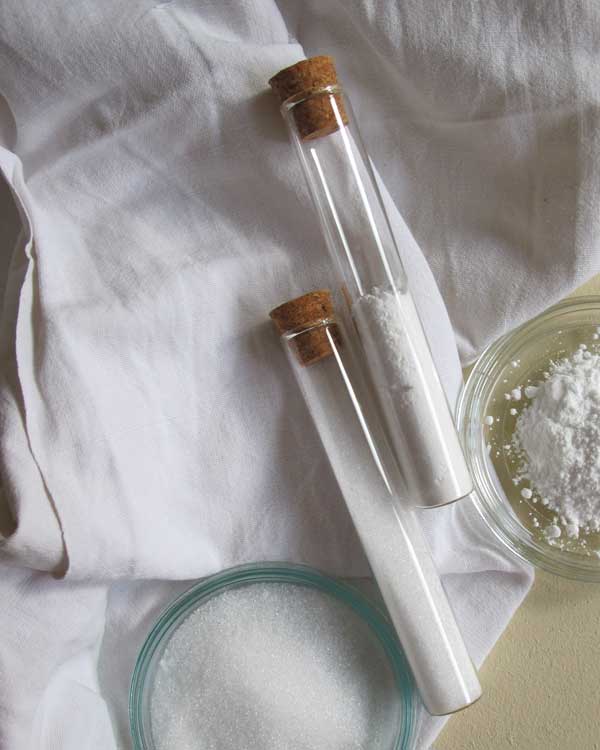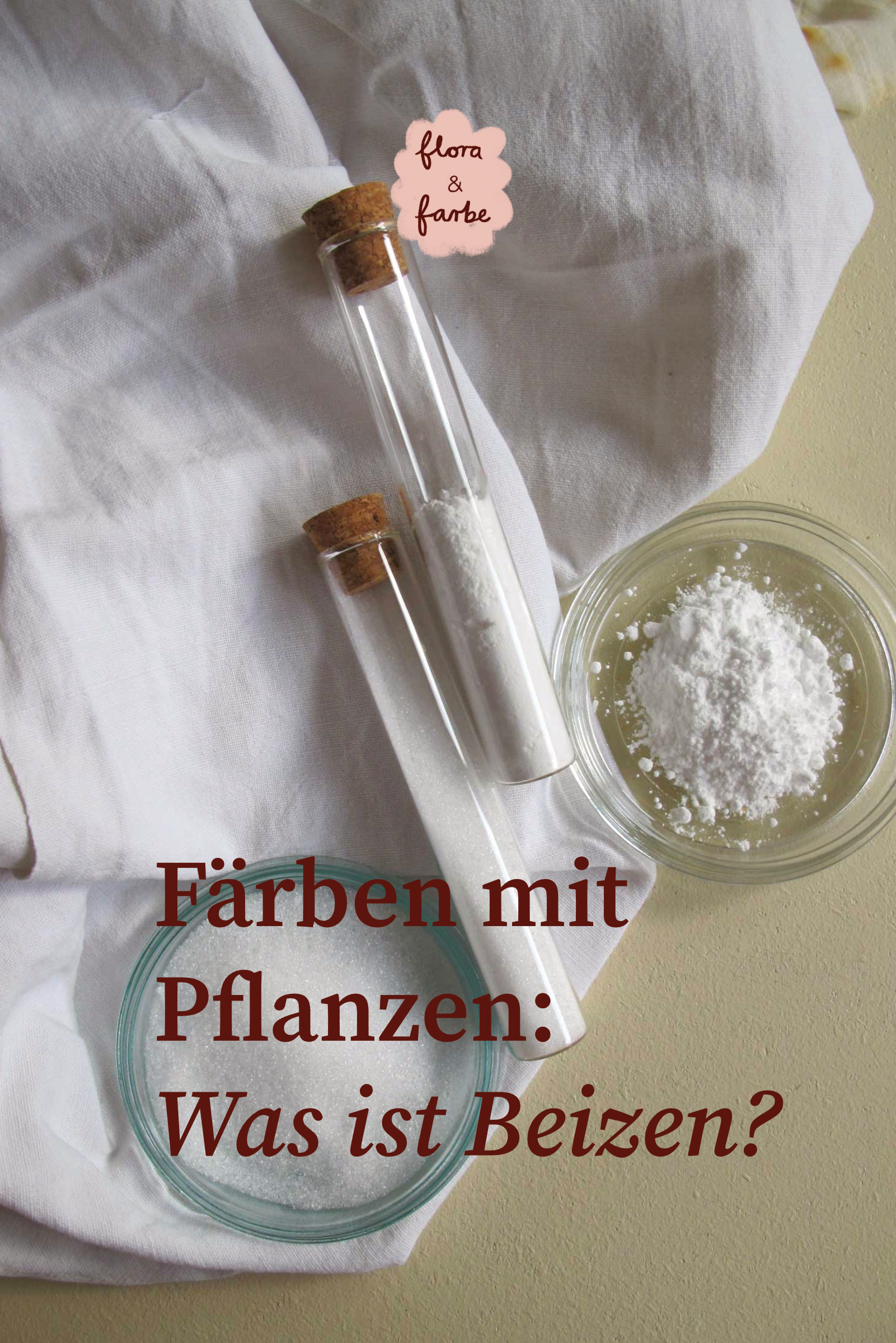Your basket is currently empty!

Plant dyeing 101: What is mordanting?
Have you already been wondering about mordants? If you have browsed instructions on how to dye with plants, you probably already know that mordanting is kind of important. Did you read about mordants but that did not go forward because the information seemed confusing? I hope to clarify some basic questions here!
Mordants form a compound with plant dyes, and thus help fixing them onto textile fibre. Mordanting improves colourfastness of plant dyes (with very few exceptions) a great deal. And while I love experimenting with plant dyes, mordanting is the one stage of the process that should be done with care and precision. But once you understand it, there is no reason why you couldn't do it at home.
Vinegar is not a mordant
I was told the following in a workshop several times: First attempts at dyeing did not work out at all, although instructions for dyeing were followed. And then it turned out, these instructions named vinegar as a mordant, for example, or baking powder, and one or both of these should have fixed the dye. Just to be safe: Please do not try at home!
How plant dyes attach to fibres
To start at the very beginning - lots of the natural dyes are so-called "adjective" dyes *. Simply put, this means that they cannot bond directly to the textile fiber (i.e. the fabric or yarn that you want to dye). You need something to “add”, so to speak, an "agent" that can bond with the fiber. This agent (figuratively I imagine it as a bridge) is the mordant: it bonds with both the textile and the dye. This is simplified – but it helps me to understand how it all works.
* In addition to these adjective mordant dyes, there are also some “substantive” dyes. They can also connect to a fiber without a mordant.
The function of the mordant
For one, pre-mordanted fibers, whether fabric or yarn, take to the dye better (or at all) when dyed with plants. Apart from that, the colour fastness of the dyes is better, especially in the long term. (Besides, the second important factor for colour fastness is the plant chosen, because different plant dyes have very different properties. But that's another topic.)
The function of the mordant is to enable a stable bond between textile and dye. The type of mordant you choose also has an impact on the resulting colour. It can make a big difference, between lemon yellow and dark gray!
Mordants are metal salts
When we talk about mordants in plant dyeing, we are referring to certain salts of various metals - but not the table salt from the kitchen, sodium chloride. The vinegar and baking soda mentioned at the beginning are not metal salts. They can change plant colors (in some colors even very radically), but this is due to the change in ph-value and does not improve the color fastness in this case.
For environmental and health reasons, salts of aluminum and iron are probably most relevant for you and me.
If you read in old(er) dye books, you will also find recipes with other metal salts, for example chrome or lead. Today they are not used at all in house dyeing (anymore). Even if you limit yourself to the two above-mentioned mordants, you can achieve a wide range of colors and don't miss out on colourfastness!
Safety in mordanting

I recommend that you stick to a few rules when dealing with mordants right from the start - so you and everyone in your household are always safe around them. By and large, stick to the same rules for dyeing with plants in general.
Pots and spoons that are used for mordanting are no longer to be used for food. If you're just starting out, a single pot will do. You might find one (made of stainless steel or enamel) at the flea market. And if you also have two 10 liter buckets to “park” liquids, that should be fine to get started.
If you are heating mordant baths, be sure to ventilate your work area well when you cannot work outside. Wear rubber gloves when measuring mordant salts or stirring your mordant bath. Not because the mordant would be "damaging" your skin right away, but because the skin can absorb substances - just suppose you want to continue mordanting and dyeing with plants for the next four decades, and hot mordants could possibly accumulate by not weearing gloves... Label the mordant/mordant baths clearly and do not leave them open and children or pets unattended with them.
Some mordants or additives are very fine powders - before you dissolve them in water, wear respiratory protection lika a dust mask during processing and, if necessary, protective goggles.
I don't intend to scare anyone or sound alarmist, but I go with better safe than sorry with mordants. The mask may be a nuisance at first - but in the end you only wear it when weighing and stirring in, so really only for a short while. (And by now we all are a lot more used to them, probably...)
Aluminum salts: Alum and "cold mordant"
There are mainly two or three different forms of aluminum that most dyers use here. Alum, the crystals of which look similar to sugar (potassium aluminum sulfate); Aluminum acetate, which as far as I know, cannot be bought in ready to use in Germany; and aluminum triformate, a very fine powder (wear a mask), often called "Kaltbeize" or "cold mordant".
Aluminum triformate is my preferred and most used mordant.

Which one you use is a personal preference, or maybe one of these mordants is simply more accessible for you.
There are different recipes for all these aluminium stains, some of which are "optimized" for different fibres. Don't be confused if you have been recommended one recipe and then find another. There are also different ways to achieve your goal when staining. (Just not the way where you are supposed to use vinegar for staining...) Choose the method that suits you and your workshop or home and your free time windows best. We discuss my favorite mordants in detail in the workshops and in the Online workshop (german).
What I like about aluminum triformate: you don't need a lot of it, you can store the liquid for a long time and use it again, and it is ideal for mordanting at room temperature, but can also be heated up a little if you want to speed it up.
Mordanting with iron
Iron can be bought as ferrous sulfate in crystal form, or you can make a home made iron solution (ferrous acetate). To make this, cover iron bits (such as rusty nails or steel wool), vinegar essence and a little water, and then wait until it changes - the solution will become rusty orange (sometimes blackish).
I prefer this home made version to ferrous sulphate. To use it as a mordant (I love to use it as a post-mordant), make sure to dilute (a lot) and soak your textile in it or add to dye baths.
Iron in particular can make fibers fragile and break down if you use too much of it. So make sure to not apply ferrous acetate undiluted. This property of iron is also the reason why I rarely use it as a pre-mordant, but rather carefully dosed after dyeing.
Soy milk binder instead of mordanting
Instead of mordanting with metal salts, you can also use soy milk. This works slightly differently, as it makes use of the fact that soybeans are very rich in protein.
The mechanism of the connection between dye and textile is different: soy milk is a traditional binder in East Asia for working with dyes and pigments.
For dyeing with plants, fabrics made from plant fibers (such as cotton, linen, hemp, for example) are soaked in diluted soy milk or coated with it and left to dry without rinsing.

This gives the cellulose fibers a protein coating and makes them behave similarly to animal fibers - wool and silk, the protein fibers. They have a high affinity for binding dyes, and the same applies to the soy pre-treatment of plant fibers.
These fabrics should also be given a longer curing time before use. This allows the protein compounds to solidify and not be washed directly from the fabric.

Natural dyes on conventionally mordanted fabrics sometimes differ more, sometimes less from those on soy-treated fabrics. Yellow tones in particular are often less brilliant, while other colors are sometimes even more saturated.
Vor allem anfangs sind die Farben hier weniger reibecht, das sollte man beim Waschen beachten. Mit der Zeit lässt das nach, weil die Eiweißverbindungen weiter aushärten.
When I use this method, I make the soy milk myself from whole soybeans, I find it more effective this way. You can also use store-bought milk, preferably with as few additives as possible.
I took my 'soy method' from John Marshall and adapted it to suit my needs. There is information on his website gibt es dazu Infos, und noch mehr in dem kleinen Büchlein ‚Salvation through Soy‘ (das wohl inzwischen vergriffen ist). Meine Methode findest du auch in meinem E-Book!
Use mordants mindfully
In general: If you buy a mordant somewhere, maybe one that is all new to you, pay attention to the safety instructions provided. They are a good reminder of what to look out for when handling the material.
For German readers I linked to a video about aluminum salts (in deodorants) by MaiLab, and whether or not they are safe to use.
PS. All information has been researched to the best of my knowledge and belief, but errors may occur. Please also inform yourself about the substances you use in dyeing. Pay attention to the correct handling of metal salts and do not work with substances you are unfamiliar with. I am not liable for any negative outcome.

Leave a Reply